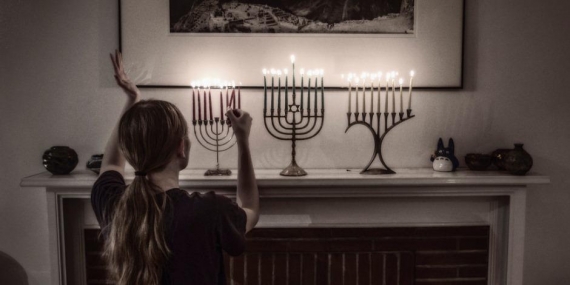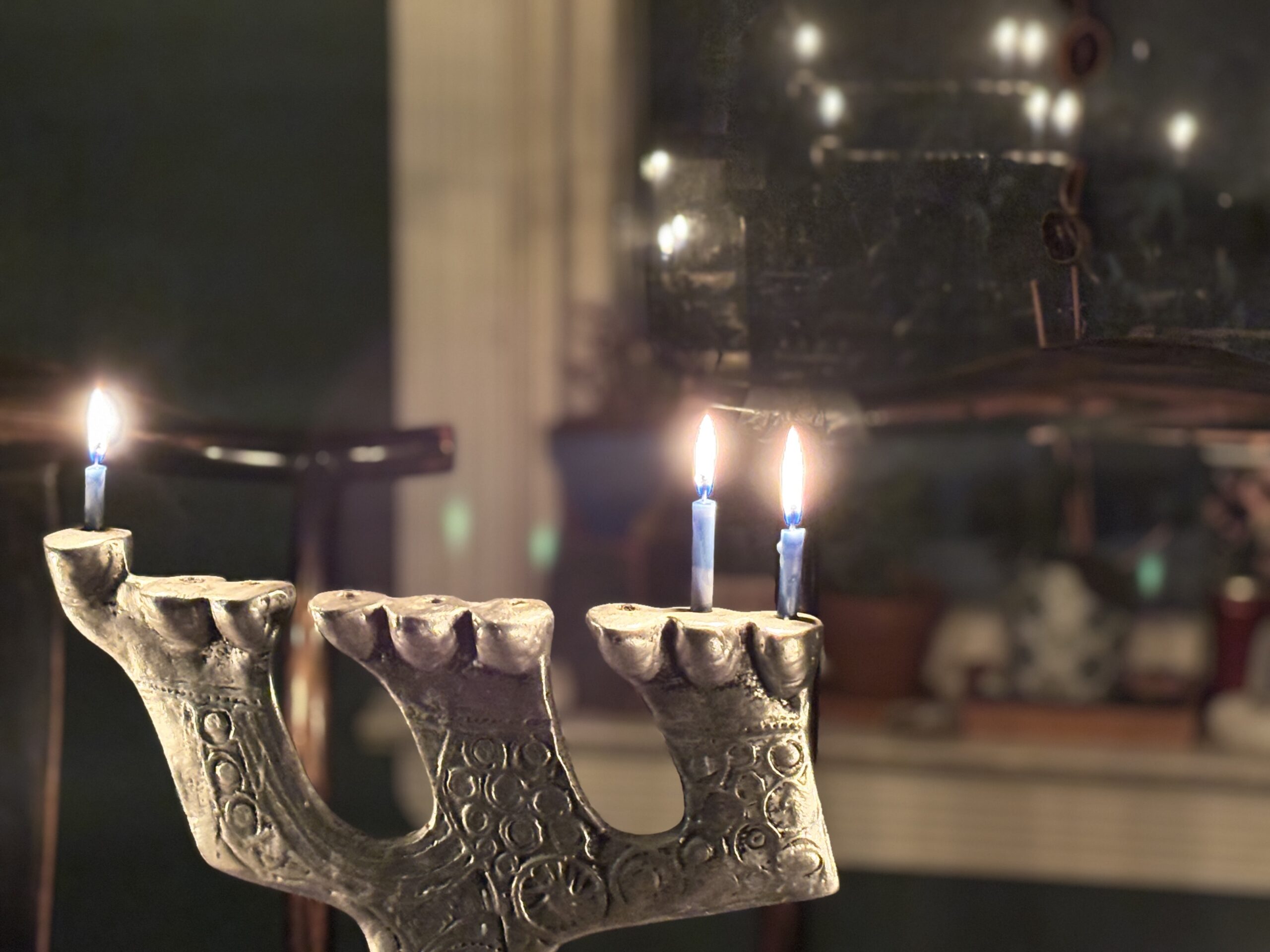On Chanukah we usually honor the Maccabees, brave men who fought with the sword against injustice. This year, we choose also to honor those courageous women who, throughout our history, have challenged injustice – not with the sword, but with word and deed. Each night, choose one of the women described below – a woman from our past – or choose a woman you know, a friend or relative, who has made a difference in the life of the community; read or tell her story. After each reading, everyone listening should repeat the woman’s name and say, “Zichronah Livrachah, May her memory be a blessing.” Then say the blessings over the Chanukiah and light the first candle of that night in her memory. You may also perform the entire ritual on the seventh night, which falls on Rosh Chodesh Tevet, “The New Moon of the Daughters. “May the light of these women’s lives continue to illuminate us.
Shamash: ShlomZion haMalkah (Salome Alexandra)
Queen of Israel, first century BCE.
This ritual is devoted to one of the last Hasmonean rulers, “ShlomZion ha Malkah,” who brought peace and prosperity to Israel after the turbulent years associated with the later Maccabean dynasty. Shlom Zion (as the Talmud refers to her) or Salome Alexandra was married to Judah Aristobolus, the first Hasmonean to take the title of king and high priest in 104 BCE.
Her husband died of a fatal illness before she had any children, leading to a levirate marriage with the successor, his twenty-two-year-old brother, Alexander Jannai, with whom she had two sons. Alexander Jannai was associated with the upper-class Sadducees and persecuted the Pharisees, whom Shlom Zion supported. During Alexander Jannai’s reign (considered tyrannical by historians), the head of the religious parliament, Rabbi Shimon Ben Shetach, was forced into exile.
However, on his deathbed, Alexander Jannai bequeathed the kingdom to Shlom Zion. She assumed the monarchy at age sixty-four and reinstated Rabbi Shimon and the Sanhedrin, an act which led to many educational and religious reforms, including the development of the marital contract, the ketubah.
The Talmud praises her wisdom and piety, indicating an almost messianic quality to the nine years she was in power; a time of abundance, justice, and peace. Historians cite her role in foreign policy; some credit her with successfully maintaining the kingdom against the surrounding empires through clever diplomacy.
Candle One: Namnah Bat ha Levi of Baghdad
Eleventh-century Persian scholar
A beautiful and wise teacher, Namnah lectured to rabbinical students in the Yeshivah of her father, Rabbi Shmuel Ben Eli, the enlightened eleventh-century Gaon of Baghdad.
Rabbi Petachiah of Regensburg described Namnah (also called Bat ha Levi) as follows:
“She is an expert in Scripture and Talmud. She gives instruction in scripture to young men through a window. She herself is within the building; whilst the disciples are below outside and do not see her.”
Stories about Bat ha Levi say that her fiancé, a scholar named Azariah, died before their wedding. Soon after, she and her father are said to have passed away on the same day! Their graves were regarded as sacred by Persian Jews, who made pilgrimages to the site.
Candle Two: Dulcie of Worms
Twelfth-century communal leader (martyred 22nd Kislev 1196)
Dulcie of Worms was part of a distinguished family of scholarly Franco-German Jews associated with the academies of higher learning in the cities of Worms, Mayence, and Speier. She was the great-granddaughter of the renowned French commentator “Rashi” (Rabbi Shlomo Yitzchaki, 1040-1105).
In a poem, Dulcie’s husband, the renowned Rabbi Eliezer Bets Yehudah of Worms, describes her religious devotion as well as her work in leading women’s prayers in the synagogue and teaching women in various cities. He tells us that she supported his scholarly work with her business activities, provided room and board for his students, and also escorted brides, sewed Torah scrolls, made candles for the synagogue, etc.
Rebbetzin Dulcie also instructed her two daughters, named Belet and Chana. Both of the girls and Rebbetzin Dulcie were brutally murdered in 1196, between the second and third crusades, when two Soldiers of the Cross broke into their house. Despite her heroic efforts to save them, both girls were killed. Her son was wounded in the same incident and later died.
Candle Three: Rebbetzin Mizrachi
Sixteenth-century Kurdistani scholar and administrator
In Amadiyah, Kurdistan, where women were held in high esteem and Jews traced their origins to the Assyrian exile, a sixteenth-century scholar offered his learned daughter, an only child, in marriage to Rabbi Jacob Mizrachi. The contract contained the stipulation that she never be troubled with housework.
The new “Rebetzin” Mizrachi (who is referred to by some authors as Osnath Barazani, the daughter of poet Samuel Barazani) worked as a teacher in her husband’s yeshivah and assumed its administration, freeing her husband to pursue his studies. Unfortunately, his death left her with two young children and a school with limited funds.
She maintained the school, with her son, for many years despite financial difficulties. In fact, her poverty has made us richer: her fundraising appeals, drafted in poetic Hebrew, have survived to document her learning, humility, and courage in the face of adversity.
Candle Four: Sarah Bat Tovim
Early-eighteenth-century eastern European liturgist
Sarah Bat Tovim is usually identified as a firzogerin (foresayer) who led and interpreted the prayers in the women’s section of the synagogue. She wrote special prayers for women, known as techinot, which were usually drafted in Yiddish.
Sarah compiled religious pamphlets for women which included language to accompany the female mitzvot (challah, candles, and mikvah) and prayers for Rosh Chodesh (new moon) and High Holidays. The two booklets attributed to her are Sheker ha Chen (Beauty is Deceptive), and Shlosha Shearim (Three Gates.)
The style of the early drafters of women’s techinot was often emulated by male writers, eager to enter the techinah market. For that reason scholars debate Sarah Bat Tovim’s historical authenticity. Whether she is archetypal or biologically real, she represents an early genre of female religious writer and teacher.
Candle Five: Soreh Bezalel
Late-eighteenth-century woman of valor
The story of Soreh Bezalel reflects the kind of faith and courage we associate with the tales of Ruth and Queen Esther. As a beautiful young woman in Germany, she proposed to an elderly teacher, Reb Yoseph, for whom she had great respect. The “Melamed” was amazed and agreed only after being convinced that Soreh was endangered by the advances of the local nobleman, who had threatened to kidnap her when she rejected his proposals.
After their secret marriage and escape to southern Poland, Soreh gave birth to Yehudah Leib Ben Bazalel, who would become an important member of the Baal Shem’s circle. Not long after the boy’s birth, her husband died.
Soreh raised the boy by herself, guiding him toward involvement with Chasiduth. He was assigned by the Baal Shem Tov and later the Maggid of Mezerich to the ransoming of Jewish captives. The early Hasidim honored his mother by calling him Rabbi Leib Soreh’s, after his mother.
Candle Six: Penina Moise
Early-nineteenth-century Sephardic-American writer
Penina Moise, a religious poet, was the first Jew to publish a book of poetry in the United States. An acknowledged contributor to the majority culture, she did so without diminishing her commitment to Jewish life and values. Her hymns, which she wrote for the congregation in her community of Charleston, South Carolina, were later compiled in Reform and Conservative hymnals.
Her Sephardic family emigrated from Alsace to the West Indies and from there to the American South. Once wealthy, they lost all their resources, and Penina’s life became one of hardship after the death of her father when she was twelve years old. This was also the year she began publishing her poems.
Clearly precocious in understanding and responsibility, she resented the fact that girls could not have a bar mitzvah and were denied more advanced Jewish education. A precursor to contemporary feminism, she is known to have scoffed at the traditional daily prayer “Thank God, I was not created a woman.”
A lifetime of financial hardship and prolific writing culminated in the loss of her eyesight during her later years. Though she lived a long, productive, and saintly life her epitaph reflects a sadness that is not uncommon among accomplished Jewish women whose energies were directed to caring for others:
Lay no flowers on my grave
They are for those who live in the sun
And I have always lived in the shadow
Candle Seven: Rachel Luzzato-Morpurgo
Nineteenth-century Italian mystical poet
Kabbalah, the mystical practice of Judaism which grew to prominence in the 16th century, popularized the notion of the Shechinah, God’s feminine presence. Yet despite its emphasis on female sacred energy, the movement itself was almost exclusively male. One of the few identified female kabbalistic scholars was Rachel Luzzato, a descendant of the Italian kabbalist Moses Chaim Luzzato.
Her family, who were quite prominent, settled in Trieste where she was schooled in biblical Hebrew, Aramaic, and secular subjects. She became conversant with the Talmud as a teenager and later studied the Zohar. She began writing poetry at the age of eighteen and continued to do so during her marriage to Jacob Morpurgo, in which she bore four children.
Living under strained financial conditions, she nevertheless continued her writing and correspondence with other scholars. Despite a demanding domestic life in which she carried out all the housework and child care for her family, she produced the numerous poems that comprise the book Rachel’s Harp.
Candle Eight: Malkele Die Triskerin
Nineteenth-century eastern European Hasidic rebbe
The practice of receiving contributions from the affluent to care for less fortunate members of the community was common among Hasidim. The women who shaped the development of this form of philanthropy included “Malkele die Triskerin” – Malka the Rebbe of Trisk – who is known for her sponsorship of public meals for the needy. She reputedly held court and received petitions twice a day, indicating a rigorous schedule of responding to her hasidim.
Malka was the daughter of Reb Avrohom of Trisk, a descendant of the Chernobyler Rebbe. After her husband Efraim’s death, Malka assumed the direction of the court and was known for her love of music. She organized a choir of great singers and enjoyed Hasidic singing and dancing after every festive meal.
Used with permission of the author. This ritual was developed into a full-length play which is available in a video version for $22 postage paid from Rabbi@ruach.org. You can also order the video on the Ruach HaMidbar website.













